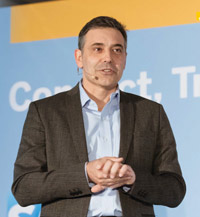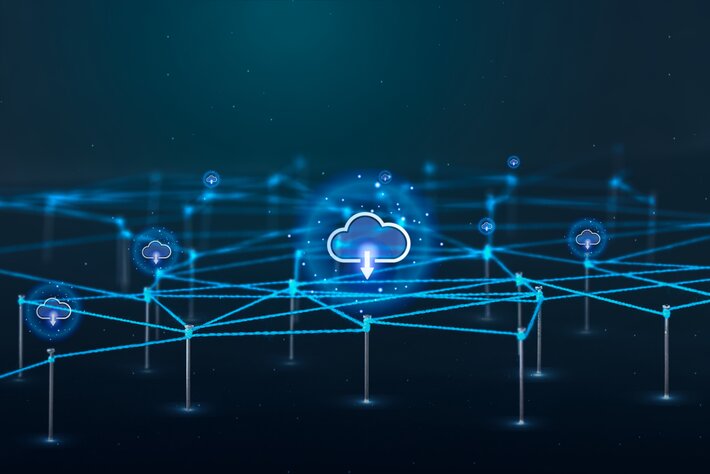Stephan Gatien, the general manager for the Telecommunications Business at SAP, talked to Tom Rebbeck, the research director at Analysys Mason, about SAP’s approach to IoT and how it is trying to help telecoms operators grow their IoT business
Tom Rebbeck: Can you give an overview of SAP’s broader strategy for Internet of Things (IoT) and where you see the opportunity for SAP?
Stephan Gatien: For SAP and many other vendors, IoT is one of the biggest proposition areas and one of the best opportunities right now. There are many dimensions to it and this presents both a huge opportunity and a huge challenge.
 The first dimension to our strategy is data and insight. Clearly the IoT world brings an explosion of data and this represents a huge opportunity for all participants. As one of the leaders in the analytics space, we have a number of assets to offer, including SAP Business Objects, Predictive Analytics and Data Management, with a focus on delivering business benefit from data and analytics, a focus on going from sensor-based noise to meaningful insight. We also have a comprehensive strategy around the management of very large volumes of data in either SAP HANA or HANA cloud platform with interoperability with Hadoop and Spark. This allows us to form a proposition that lets our customers manage and optimise the analysis of all this IoT data.
The first dimension to our strategy is data and insight. Clearly the IoT world brings an explosion of data and this represents a huge opportunity for all participants. As one of the leaders in the analytics space, we have a number of assets to offer, including SAP Business Objects, Predictive Analytics and Data Management, with a focus on delivering business benefit from data and analytics, a focus on going from sensor-based noise to meaningful insight. We also have a comprehensive strategy around the management of very large volumes of data in either SAP HANA or HANA cloud platform with interoperability with Hadoop and Spark. This allows us to form a proposition that lets our customers manage and optimise the analysis of all this IoT data.
We are also looking at how to make the most of this data in various ways and how to optimise processes on the fly. To help us do so we recently acquired Plat.One. One of the attractions for SAP is that the company provides us with a cloudready, Hadoop-friendly environment that can help us achieve success both in delivering enterprise-grade performances for IoT and in delivering superior insight from the huge traffic of data.
TR: The first dimension to your IoT strategy is your focus on driving insight from IoT data. What is the second?
SG: The second dimension is turning this insight into meaningful business outcomes. The arrival of sensor-enabled processes will enable new opportunities to automate and optimise processes in manufacturing industries – such as Industry 4.0 – and a number of other domains.
As the provider of business process centric solutions in 25 industries, SAP wants to ensure that the evolution towards sensor-based processes is used to optimise operations and to make a business impact. Having the capacity to measure anything on the edge is meaningless if the information cannot be utilised and turned into both action and outcomes. Our ambition is to use the capacity of the sensors to enhance and make any business process more meaningful in each industry or sub-industry.
In that domain, we also expect the acquisition of Plat.One to help us deliver a more enterprisegrade performance for many IoT-centric scenarios and use cases.
TR: And what’s the third dimension?

IoT presents both a huge opportunity and a huge challenge
SG: The third dimension is our proposition to telcos and that is where my team and I directly play.
We are exploring how SAP can help telcos deliver meaningful solutions beyond pure connectivity to customers, that will help them be differentiated in solutions across multiple industries, such as energy, healthcare, smart metering or others.
We can do that because we are already present in all of those markets and we understand each industry. We are currently trying to make sure that this knowhow becomes as IoT-centric or IoTfriendly as possible. We are working to become a provider of channel solutions for telcos.
TR: Can you give an example of a project you are involved in?
SG: One interesting example is the work we have done with Deutsche Telekom and the Hamburg Port Authority in Germany. I would characterise this as co-innovation or joint innovation where the customer brings a specific business problem and we work together on delivering a solution. In this case the problem was how to manage container throughput efficiently.
Making use of our knowhow in asset management and moving assets, and combining this with Deutsche Telekom’s IoT proposition, we developed a system to optimise traffic, based on sensor information from trucks and ships approaching the port.
TR: How did you get involved in this project?
SG: In the Hamburg case there was a business problem that both Deutsche Telekom and SAP were aware of and, because of our historical relationship, we agreed to join forces.
TR: How do you manage that model given that you are selling directly to enterprises as well as working with telcos? How do you avoid conflicts?
SG: It is a great question and I would be lying if I said that we have sorted everything out. I believe that as more and more of these cases surface, we will have to learn how to best manage our traditional go-to-market strategy, and how to minimise potential friction between channels. At this point we have not reached that stage but I do believe that the question is valid that there is a risk here and we should address it.

TR: How do you see the approaches of the telcos differing?
SG: Depending on the level of maturity and the level of ambition of the telco we will probably see different strategies. I think we can assume that very well-funded, large tier one players will take a certain approach, particularly in terms of ownership of the final product. We could though envision tier two and tier three players being more in need of turnkey solutions and being much more open to agreements with players like SAP.
TR: Has that emerged yet with the conversation with the telcos or is it too early?
SG: There are still a lot of question marks on how to grow and deliver profitable results with IoT. Some more established telcos have already expressed their interest in creating a vendor-friendly channel framework that could allow them to assemble the portfolio of solutions targeting specific industries. These conversations have not translated into commercial agreements yet but this is just a matter of time.
TR: Are there any particular areas you are developing products in?
SG: One of our big focus areas right now is to create a meaningful and impactful set of applications for smart cities. It is an attractive area as it touches on the multi-industry angle that we believe is one of our strengths. Smart cities touch on utilities, flood response, transportation, healthcare and other sectors. That is going to cut across industries that we are strong in. The challenge for us is to assemble it all in a meaningful fashion.
Smart cities are also interesting as, in some parts of the world, telcos are seen as the preferred mechanism to deliver not only connectivity but the full solutions. We believe that there is a path for us to work with telcos.
TR: In which parts of the world do you think telcos are seen as the preferred mechanism?
SG: Right now we see a huge amount of activity in this space in the Middle East and North Africa (MENA) region. We are seeing it translate into a lot of activity from the telcos themselves. We have seen telcos like Zain making direct investment in smart city joint ventures.
TR: Smart cities are an interesting area with lots of different use cases. Earlier you also mentioned oil and gas. Are there vertical markets that you are involved in or you think you will be attractive for SAP?
SG: I think energy and natural resources, utilities and mining would clearly be spaces that all get our focus. Consumer industries is another space, retail, for example, could involve things like store replenishment or learning from consumer behaviour in stores.
TR: And connected cars? For telcos, connected cars is the big opportunity. Is it something that you are working on?
SG: Connected cars are an area where telcos clearly have traction. There are a lot of direct activities between telcos and car manufacturers. The challenge for us, as we engage with telcos, is to understand how we can enhance the agreement that a telco has with a car manufacturer.
We believe that there may be an opportunity to provide a layer that would enable the telco to add value to the car manufacturers. We have a solution called Vehicle Insights which makes the most of telematics information coming from a vehicle. Enabling telcos to offer this in their portfolios is one direction we are considering.
TR: Do other industries lend themselves to working with the telcos?
SG: Another one is healthcare. Both in Europe and North America we have seen some telcos starting new divisions, like Telus in Canada which is betting big on healthcare, or Swisscom, which is relatively active in that sector. They are looking for partners to co-innovate around some new solutions, like how to store patient records. That is clearly also an active area.
TR: Telus is an interesting example – it has bought something like fifteen different companies, mostly around electronic patient records.
SG: They clearly identified early on the opportunity to build the stack and insert themselves as the key stakeholder in the digitalisation of the health business in Canada, which I think was a smart strategy.
I think that connected car, smart cities and healthcare are the domains that are compelling and are front and centre in our conversations with telcos.
More telcos are also getting more requests to go beyond connectivity. We are talking to a tier one telco that was approached by one of their business customers in the oil and gas industry who would like to engage in a different way. This customer wants to support more of its core business with sensors in its rigs and on its trucks. That opens up a bunch of opportunities for SAP, particularly because this customer was a wall-towall SAP customer. Going back to my earlier point, we have a very solid customer base across 25 industries, we might be able to help telcos as they try to serve their customers better and also look for new revenue streams beyond connectivity.
TR: Finally, given the time of the year, what are your expectations for 2017? Any predictions?
SG: My hope is that in 2017 we get to a point where IoT becomes more tangible and more operational. In terms of the relationship between SAP and the telcos, I believe that up to now, we have seen good examples of what is possible, but it is relatively modest and on the edge of what can be achieved. My hope is that, in 2017, we will engage the next gear in terms of executing more meaningful and ambitious projects involving SAP and telcos.










